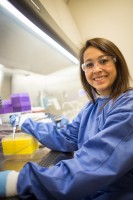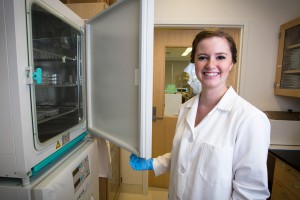On their way to becoming doctors
by Kathleen McCoy |
I recently had the opportunity to drop in on WWAMI medical students working with biomedical researchers on campus. Both, two young Alaska Native women, were still relishing the fact that they'd survived year one of medical school at UAA, and gearing up for year two in Seattle at the University of Washington.

Hazel Brogdon grew up in Anchorage and pitched softball as a Mustang for Chugiak High School. Now, post-college, she's doing biomedical research as a WWAMI medical student. (Photo by Ted Kincaid/University of Alaska Anchorage)
Hazel Brogdon, a fierce softball player, pitched as a Mustang for Chugiak High School and later Marietta College in Ohio. A high school opportunity to shadow an anesthesiologist during a gifted mentorship planted the M.D. idea. After college, she worked a year in suicide prevention at the Alaska Native Tribal Health Consortium (ANTHC), then started medical school. She's the first in her family to go to college.

Dimond High and UAA grad Michelle Warner just finished her first year of medical school with WWAMI here at UAA. She's spending the summer working on iqmik and how it affects healing rates of gum cells in biomedical researcher Cindy Knall's lab. (Photo by Ted Kincaid/University of Alaska Anchorage)
Michelle Warren was an "uninspired student" at Dimond High School, she says, but after a Southcentral Foundation summer internship exposed her to the drama of hospital operating rooms, she found purpose and direction. That meant shoring up gaps in her high school academics before graduating with a biology degree from UAA and heading right into medical school. Warren says that no matter how tough medical school is, she's now "too stubborn to quit."
Their medical school, WWAMI, is a collaboration among universities in Washington, Wyoming, Alaska, Montana and Idaho that has been delivering doctors to the Northwest for more than 40 years. Over that span, it has evolved dramatically.
Alaska's program began with just five students in Fairbanks in 1971, but eventually grew to 10 and moved to Anchorage in 1989. In 2007, annual class size doubled to 20. A more modern medical curriculum will roll into the classroom in 2015 and allow Alaskans to complete year one and two at home. Historical data show that already half of every Alaska class returns to practice medicine in the state.
When new Alaska WWAMI director Jane Shelby arrived in 2012, she recognized the potential for a research network among the many hospitals, two universities, and federal, state and private research institutes located in the Anchorage U-MED District. The goal of the newly formed U-MED District Research Alliance (UMEDRA) is to build a biomedical research infrastructure that will encourage funding and engage local medical professionals and university and medical students in collaborative research.
The opportunities that Brogdon and Warren have this summer are an outgrowth of this new affiliation. Their work is being funded by the Native American Research Centers for Health (NARCH), an agency formed in 2000 to cultivate a future cadre of Alaska Native and Native American scientists. NARCH selected ANTHC, with UAA as its academic partner, for the current grant.
Brogdon is working with Brenna Simons, an ANTHC medical researcher tracking the resiliency of hepatitis B vaccinations that are 30 years old. In other words, are persons who were vaccinated against hepatitis B beginning in 1980 still protected?
Simons works with Brian McMahon, a medical doctor who directs the Liver Disease and Hepatitis Program at the ANTHC. McMahon pioneered a vaccine to stem the spread of hepatitis B, an infectious inflammatory illness of the liver that can cause cancer. The situation was so dire in the late 1970s and early '80s in Alaska that Simons said clinicians saw children who already had liver cancer. The vaccination nearly eradicated the disease.
Research shows that vaccinated patients have little or no sign of antibodies in their blood anymore, yet when boosted, have a very successful antibody reaction. This suggests they are still protected. Researchers want to be sure.
Thanks to McMahon's work, Simons has three decades of data on immune responses against hepatitis B. Brogdon will spend her days measuring different proteins expressed by T cells, a kind of white blood cell that plays a role in immunity. Researchers are unsure of that role in the hep B vaccine and hope Brogdon's work will advance understanding.
Michelle Warren will work with biomedical researcher Cindy Knall, a WWAMI professor of medical education. Knall has long worked to understand the effect tobacco smoke has on lung cells. In recent years, she's turned her attention to understanding how blended tobacco leaves and punk ash fungus, known as iqmik, triggers inflammation in cells in the mouth.
Warren's work compares healing rates of gum cells exposed to chewing tobacco versus iqmik. The high pH of iqmik allows nicotine to cross into the blood stream easily. Iqmik-exposed cells heal more slowly, Warren says. "My question now is whether the difference in healing is a difference in the pH (between straight chewing tobacco and iqmik), or some other component of iqmik."
Health disparities for Alaska Native people are significant, including higher rates than non-Natives for cancer, cardiovascular disease, hypertension, diabetes and suicide. Brogdon tells a story of interviewing an Alaska Native elder who realized the young Inupiat woman was on her way to becoming a doctor. The elder told Brogdon how proud she was of her.
"That experience was validating," the young medical student said. "I know that I am where I need to be."
A version of this story by Kathleen McCoy appeared in the Anchorage Daily News on June 29, 2014.
 "On their way to becoming doctors" is licensed under a Creative Commons Attribution-NonCommercial 4.0 International License.
"On their way to becoming doctors" is licensed under a Creative Commons Attribution-NonCommercial 4.0 International License.














